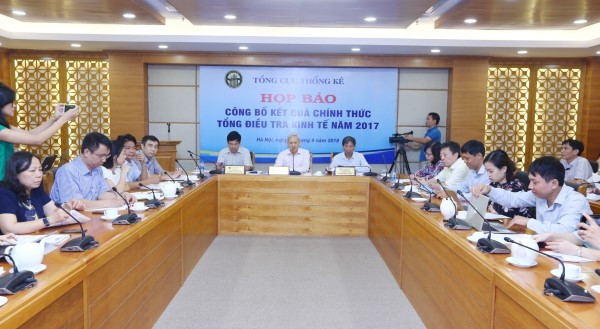Hanoi (VNA) – Nearly 517,900 businesses were operating in Vietnamin 2017, rising 51.6 percent from the figure recorded in 2012, according to thegeneral economic census announced by the General Statistics Office of Vietnam(GSO) on September 19.
Despite the strong growth in the number of enterprises, there were only justover 10,000 large companies, accounting for a mere 1.9 percent especially incomparison with the dominating 98.1 percent of small- and medium-sized firms.
The southeastern region was home to nearly 216,000 businesses, accounting for41.7 percent of all companies operating in the country.
The GSO said that the results of business operations and production in 2016 wasbetter than in 2011, with net revenue recorded at 17,858 trillion VND (767.89billion USD), 71 percent higher than that five years earlier.
Net revenue during 2011-2016 surged 11.4 percent or 1,400 trillion VND (60.2billion USD). The non-State business sector had the largest earnings, making upof 55.9 percent of the total net revenue recorded in the business sector.
Head of the GSO’s Industry Statistics Department Pham Dinh Thuy said that thestrongest growth in net revenue was seen in FDI enterprises, which expanded134.5 percent in 2016 as compared to 2011.
Meanwhile, State-owned firms only contributed 16.7 percent to the net revenue.
Return on assets (ROA) of the companies were calculated at 2.7 percent in 2016,with the highest rate recorded in the FDI sector (6.9 percent), followed by State-ownedfirms (2.6 percent) and non-State firms (1.4 percent).
The industrial and construction sectors reported substantial ROA with 4.8percent, while the profitability ratio in the agro-fishery-forestry and servicesectors were 2 percent and 1.6 percent.
GSO General Director Nguyen Bich Lam urged the Government, ministries, sectorsand localities to complete institution-building, accelerate the reform ofadministrative procedures, and produce rational measures to remove bottlenecksfor enterprises and household businesses.
As economic development in the context of the Fourth Industrial Revolution verymuch depends much on the quality of human resources, Lam said: “It is necessaryfor the Government to renew training methods to meet Industry 4.0 requirements”.–VNA




























